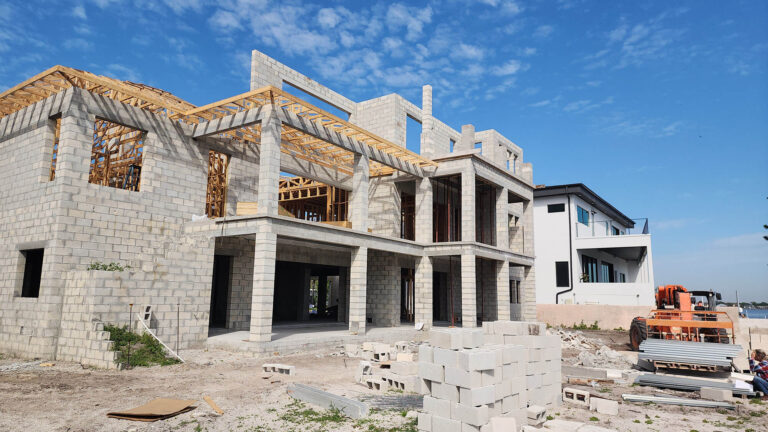When it comes to building a new house, you need assistance with all the materials and designs available to make your selection. These are things like how it appears, how long it will last, and its durability. Therefore, one system that you should consider is using multi-story concrete block walls for your new home. They offer more than functionality; they also offer many advantages contractors should know while constructing such dwellings.
In this comprehensive guide, we will discuss the advantages and disadvantages of multi-story concrete block walls for residential projects.
What Are Multi-Story Concrete Block Walls?
Multi-story concrete block walls are solid concrete blocks stacked on top of each other, forming a vertical load-bearing wall. This creates a wall system that can go up or down over several levels.
These walls hold the building together, supporting and protecting it throughout its lifespan. The blocks usually consist of reinforced concrete, thick pieces of concrete made from other materials and cementitious binders. Afterward, the blocks are laid in “a running bond” formation and stuck together using mortar to form the wall structure.
This rugged wall system can tolerate different environmental and structural loads. Since they are strong and durable and there are several ways of putting them up, multi-story concrete block walls are commonly used in constructing residential, commercial, and industrial buildings.
Creating Multi-Story Concrete Block Walls
After establishing the purpose of multi-story concrete block walls in the preceding section, let’s examine their construction processes here.
Site Preparation
Before any construction takes place, the site should be cleared, leveled, and prepared. Afterward, excavation is done to create a foundation that corresponds to the design and engineering plans for holding up the wall.
Base Installation
At this point, you have excavated the earth, which has been poured with a gravel bed and reinforced with steel rebar. The foundation is crucial in ensuring that multi-story concrete block walls remain stable and robust.
Layout and Marking
The foreman will set out the walls and mark the foundation’s layout as required. The reference lines ensure that the concrete blocks are square and in their correct positions.
Blocks Stacking Up
What then follows is the piling up of one concrete block over another so as to construct walls. These blocks are typically made of solid rock and cement, lasting long. Each layer of these blocks is filled with a mixture of cement, water, and sand called mortar, which holds them together, forming a solid structure.
Placing Reinforcement
In addition, these walls may include steel reinforcement, such as rebar or welded wire mesh, that makes them stronger and able to support loads from the side, upward or downward forces. Steel reinforcement is inserted vertically and horizontally to ensure the structures’ durability, firmness, and steadiness. When all blocks have been put in place, grout or concrete pours into each cell to avoid spaces between them.
Drying and Curing
After constructing the walls, it is crucial to let them cure and dry completely for maximum durability. To retain moisture within this time frame, wet burlap or plastic sheets can be draped over the surface of the walls.
Add Roughing Ins
After installing the concrete block walls, ensure that you incorporate rough-ins for mechanical, electrical, and plumbing in accordance with the project’s specifications.
Inspection and Quality Assurance
Following this, quality control and assurance are crucial to verify conformity with government and industry-set standards and ensure the safety of concrete block walls. Certified building inspectors and experts undertake rigorous inspections to assess compliance with structural specifications, ensuring strict adherence to set quality measures for overall security purposes.
Finishes
The owner can finally move into the unit when all required testing and commissioning have been completed, signifying that construction is finished.
Constructing multi-level concrete block walls mandates meticulous planning, top-notch craftsmanship, and excellent design-oriented building methods to achieve a satisfactory outcome that fulfills the requirements and meets expectations.
Overall, building multi-story concrete block walls requires careful planning, high-quality craftsmanship, and exceptional design-build techniques to produce a quality structure that meets the needs and expectations.
Advantages of Using Multi-Story Concrete Block Walls
As discussed earlier, multi-story concrete block walls can offer many benefits when used for residential projects. Overall, the advantages of using multi-story concrete block walls make them a preferred choice for many construction projects. They offer a combination of strength, durability, energy efficiency, and design flexibility that meets the diverse needs of builders and occupants alike. In this section, we have listed some advantages you can realize.
Strength And Stability
Concrete block walls with multiple stories can give your new home unmatched strength and stability. Concrete blocks, mortar, and reinforcement steel bars are used together to build multi-story concrete block walls. The blocks are stacked on top of each other at different heights, and mortar is spread between each layer to make the building solid and stable. These walls are solid against outside forces like wind, earthquakes, and strikes.
Thermal Efficiency
With rising energy costs and environmental concerns, it is impossible to stress enough how important it is for homes to be thermally efficient. Multi-story concrete block walls are great at this because they insulate better than other types of walls and help keep rooms at a comfortable temperature all year. The concrete blocks are thick and solid, naturally stopping heat from moving, resulting in lower energy bills and more comfort.
Noise Insulation
Making your home a peaceful haven, away from noise, is a luxury many people desire. Concrete block walls with multiple stories are the best soundproofing materials available as they keep outside noise from getting into living areas. This is because they are thick and heavy, so when the sound waves hit the firm structure of concrete blocks, they are absorbed and slowed down.
Resistance to Fire
The integrity of a residence’s construction can determine whether it endures minor damage or is destroyed during a fire incident. Multi-level, solid concrete block walls are inherently resistant to catching fire and provide an indispensable level of security for both occupants and assets inside. By contrast with combustible substances such as wood, the use of these blocks doesn’t contribute to the expansion of flames, ensuring that inhabitants have sufficient time to flee from danger while firefighters work on controlling any resulting blaze.
Multi-story walls made of concrete blocks are naturally resistant to fire due to the non-flammable nature of concrete. Unlike wood, which can quickly catch fire and contribute to expanding fires, heated-up concrete blocks remain intact and secure.
Flexibility of Design
Despite popular belief, multi-story concrete block walls can have a pleasing aesthetic appeal. Due to advancements in building methods and architectural design, concrete blocks are now versatile enough to be incorporated into various styles, ranging from contemporary designs with clean lines to traditional rustic charm.
Collaboratively, contractors and clients can devise fresh design concepts that showcase the innate splendor of concrete block walls while catering to customers’ preferences and requirements. Leveraging textured finishes, intricate patterns, or bright hues transforms simple concrete block walls into a unique canvas
to unleash your artistic creativity.
Cost-Effectiveness
In many cases, multi-story concrete block walls can be more cost-effective than alternative construction methods, particularly in terms of long-term maintenance and durability. The inherent strength and durability of concrete blocks reduce frequent repairs and maintenance in the long run, so these structures can last for generations and stand the test of time.
Environmental Sustainability
Concrete is a widely available and recyclable material, making multi-story concrete block walls a sustainable choice for construction projects. This means that there will be less waste as you go. Additionally, the thermal efficiency of concrete blocks reduces energy consumption, contributing to overall environmental sustainability and reducing the building’s carbon footprint.
Speed of Construction
Compared to traditional construction methods, such as bricklaying or timber framing, constructing multi-story concrete block walls can be relatively fast and efficient. Precast concrete blocks and standardized construction techniques can streamline the building process, reducing construction time and labor costs.
Disadvantages of Using Multi-Story Concrete Block Walls
Multi-story concrete block walls have many benefits, but they also have some problems you should consider. We have listed here a few disadvantages:
- One possible downside is that the blocks are heavy, making building more expensive and need more support.
- Installing concrete block walls may also require more work than other building methods, which could make the project take longer and cost more labor.
- Another thing to consider is that concrete blocks are more flexible in terms of design than other materials, like wood or steel frames.
Key Takeaway
In conclusion, using multi-story concrete block walls in new home building projects has many benefits for homeowners and contractors. It keeps your home strong, stable, and healthy without costing too much.

